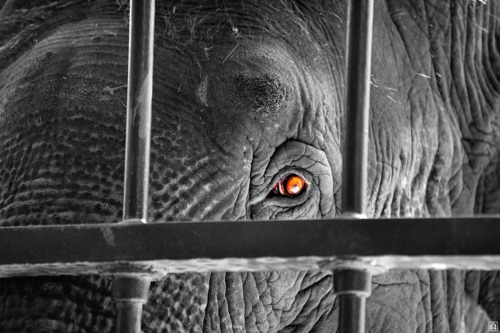The Fallacy of Noah’s Ark Propaganda
The homepage of the Association of Zoos & Aquariums (AZA) advertises: “Visit an AZA-accredited zoo or aquarium and help make a difference for wildlife”, implying that merely visiting one of these commercial establishments is a conservation action on its own. Despite the fact that there is no evidence for it, it is an apparently effective marketing message.
A recent report of the birth of a chimpanzee at the Sunset Zoo in Kansas was accompanied by this from zoo director, Scott Shoemaker:
“Births like this are a testament to our AZA community – a great example of how we ensure these endangered animals are around for generations to come while we work to eliminate the serious threats they are facing in the wild.“
But it isn’t clear exactly how Shoemaker and his colleagues plan to deal with those “serious threats.” The message is obvious: There’s no need to worry about chimpanzees, they’re safe with us, and you and your children will always have an opportunity to see one.
In the past few months the Georgia Aquarium has applied to import 18 wild-caught beluga whales into the U.S. for captive display, using conservation as a justification. William Hurley, senior vice-president of the aquarium claims that marine institutions need a strong captive population for research that can help safeguard the beluga as its Arctic habitat is transformed by a changing climate.
“If you don’t have enough of these animals in our care and don’t have enough to extend that for more decades,” Hurley said, the aquarium will be unable to unlock “the secrets these animals hold.”
However, the beluga population held captive is not endangered and obscure statements about “unlocking secrets” do not make for a conservation plan.
In fact, zoos are often explicitly referred to as Noah’s Arks. A 2006 book by Jeffrey P. Bonner entitled Sailing with Noah: Stories From the World of Zoos is an example.
The zoo and aquarium industry has used the public’s increasing awareness of conservation issues to re-brand itself as a modern-day Noah’s Ark.
The zoo and aquarium industry has used the public’s increasing awareness of conservation issues to re-brand itself as a modern-day Noah’s Ark. Through their captive breeding programs, these facilities claim to be in the business of safe-keeping those species who are bound for extinction. The mass extinctions of many charismatic animals, such as elephants, lions, great apes and others provide a convenient justification for confining individuals of these species in artificial enclosures. Combine this with the false claim that animal displays lead to increased conservation awareness on the part of the visiting public, and it’s clear that the zoo and aquarium business has seized upon a brilliant rhetorical tool for public relations.
How realistic are all of these “conservation” efforts? Animals are complex organisms that thrive in an intricate dynamic environment. Once their natural habitat and ecosystem is gone, it is nearly impossible for captive animals to be reintroduced “to the wild” to lead natural lives. There will be nowhere for them to go. Zoos and aquaria spend minimal resources on reintroducing captive animals to their natural environment. And even if the industry stepped up its commitment to wildlife conservation, it is highly unlikely they would be successful given the rapid disappearance of natural ecosystems.
Beyond these critical issues, it might be argued that the Noah’s Ark messaging of zoos and aquaria actually contributes to extinction trends. Dr. Randy Malamud, author of Reading Zoos: Representations of Animals and Captivity (1998) suggests that zoos are simply palliating anxieties about a disappearing natural world and providing false hope that species are being protected. This kind of talk supports the dangerous notion that as long as enough individuals are in captivity we need not concern ourselves about their natural habitat – an attitude that clearly does not promote environmental and ecological efforts. Moreover, a recent peer-reviewed paper by Schroepfer et al (2011) provides evidence that seeing chimpanzees in commercials and in entertainment venues distorts the public’s perception of their endangered status in the wild and actually hinders chimpanzee conservation efforts.
These are alarming “tip of the iceberg” signs that the Noah’s Ark messaging of the zoos and aquarium industry may actually be hampering conservation progress. But why should the zoo industry worry? Tickets will be half-price on holidays and children under two will still be admitted free.

